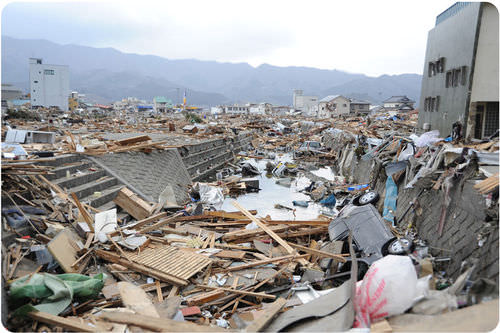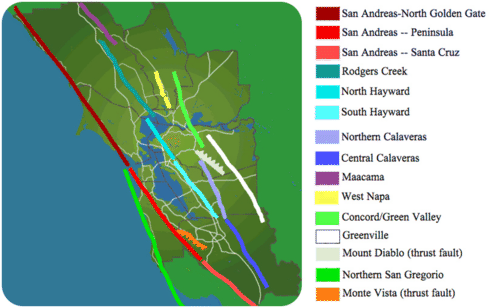READ: Earthquakes and Volcanoes
READ: Earthquakes and Volcanoes
What damage is done to people's lives by earthquakes? In a large earthquake hundreds or thousands of people may die. Many more may lose their homes and livelihoods.
Earthquakes at Convergent Plate Boundaries
Earthquakes at convergent plate boundaries mark the location of the subducting lithosphere. The motion of the lithosphere as it plunges through the mantle causes the quakes. At greater depths, the plate heats up enough to deform. Convergent plate boundaries produce earthquakes most of the way around the Pacific Ocean basin. Examples of earthquakes at convergent plate boundaries are listed below.
- Ocean-Ocean: Japan
Earthquakes in Japan are caused by ocean-ocean convergence. In this part of the Pacific Ocean, oceanic crust subducts beneath oceanic crust. This creates as many as 1,500 earthquakes every year.
In March 2011, the 9.0 magnitude Tōhoku earthquake struck off of northeastern Japan. Damage from the quake was severe. Even more severe was the damage from the tsunami generated by the quake. A tsunami is an enormous ocean wave or set of waves generated by an underwater earthquake. In all, 25,000 people were known dead or missing.
- Ocean-Continent: Cascades
The Pacific Northwest of the United States is at risk from a potentially massive earthquake. The subduction of three small plates beneath North America produces active volcanoes, the Cascades. The region also experiences earthquakes. However, large earthquakes only hit every 300 to 600 years. The last was in 1700. That quake had an estimated magnitude of around 9. A quake of that magnitude today could produce an incredible amount of destruction and untold fatalities.
- Continent-Continent: Asia
The collision of two continents also creates massive earthquakes. Many earthquakes happen in the region in and around the Himalayan Mountains.
Earthquakes at Transform Plate Boundaries
Transform plate boundaries produce enormous and deadly earthquakes. These quakes at transform faults are shallow focus. This is because the plates slide past each other without moving up or down.
The San Andreas Fault that runs through much of California is an enormous transform plate boundary. It is the plate boundary between Pacific and North American plates. The largest earthquake in recorded history on the San Andreas Fault occurred in 1906. The quake's epicenter was just north of in San Francisco. About 3,000 people died and 28,000 buildings were lost, mostly in the fire that followed the earthquake.
There are many other faults spreading off the San Andreas, to take up the plate motion. In total the San Andreas Fault system produces around 10,000 earthquakes a year (figure below). While most of those earthquakes cannot even be felt by people nearby, occasionally one is very strong. In the San Francisco Bay Area, the Hayward Fault was the site of a magnitude 7.0 earthquake in 1868.
Although California is prone to many natural hazards, including volcanic eruptions at Mt. Shasta or Mt. Lassen, and landslides on coastal cliffs, the natural hazard the state is linked with is earthquakes. In this video, the boundaries between three different tectonic plates and the earthquakes that result from their interactions are explored.
Volcanoes at Convergent Plate Boundaries
Converging plates can be oceanic, continental, or one of each. If at least one is oceanic, it will subduct. A subducting plate creates volcanoes. Many of the world's volcanoes are the result of subduction at a convergent plate boundary. A map of the world's active volcanoes is pictured below.
Melting
Mantle melting can come about three ways: (1) when the temperature rises, (2) if the pressure lowers (which lowers the melting point), and (3) if water is added, which lowers the melting point. Two of these (1 and 3) might explain why there are volcanoes at convergent plate boundaries: the temperature of the subducting plate increases as it sinks into the hot mantle (1). Sediments lying on top of the subducting plate contain water. As the sediments subduct, the water rises into the overlying mantle material. This lowers the melting temperature of the mantle (3). When the mantle above the subducting plate melts, volcanoes form above it. This leads to volcanoes in an island arc or continental arc.
Pacific Rim
Convergent plate boundaries are found around much of the Pacific Ocean basin. Trenches mark subduction zones. Volcanoes are found in an arc above those subduction zones.
The Cascades (figure below) are a chain of volcanoes at a convergent boundary. In this region, an oceanic plate is subducting beneath a continental plate.
Volcanoes at Divergent Plate Boundaries
At divergent plate boundaries hot mantle rock rises into the space where the plates are moving apart. As the hot mantle rock rises, it goes from higher to lower pressure. This is because there is no longer the weight of all the rock above it. Lower pressure lowers the melting temperature of the rock. This is why there is volcanism at divergent plate boundaries. Lava erupts through long cracks in the ground, or fissures.
Mid-Ocean Ridges
Volcanoes erupt at mid-ocean ridges, such as the Mid-Atlantic ridge. Seafloor spreading creates new seafloor in the rift valleys. This type of volcanism makes all of the ocean floor! Where a hotspot is located along the ridge, such as at Iceland, volcanoes grow high enough to create islands (figure below).
Continental Rifting
Eruptions are found at divergent plate boundaries as continents break apart, known as continental rifting. The Mount Gahinga volcanoes (figure below) are in the East African Rift between the African and Arabian plates. Baja California is breaking apart from mainland Mexico, also by continental rifting.
Summary
- Earthquakes occur all along the subducting plate as it plunges into the mantle.
- All three types of convergent plate boundaries produce massive earthquakes.
- Subduction zones around the Pacific Rim are responsible for many of the world's earthquakes.
- Transform fault earthquakes have shallow focus because the plates meet near the surface.
- The San Andreas Fault is actually a fault zone made up of a number of other active faults.
- Subduction at convergent plate boundaries leads to melting and volcanoes.
- Convergent plate boundaries line the Pacific Ocean basin so that volcanic arcs line the region.
- Melting at divergent plate boundaries is due to release of pressure.
- At mid-ocean ridges seafloor is pulled apart and new seafloor is created. Rifting in a continent can create a new ocean eventually.






